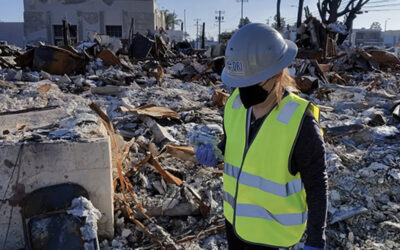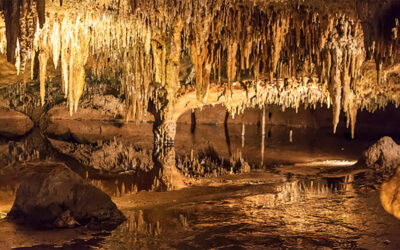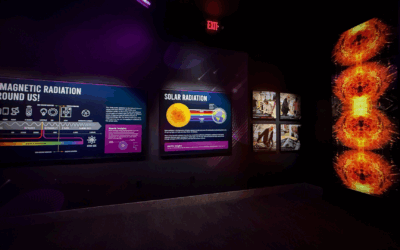This summer, DRI brought eighteen students from Truckee Meadows Community College (TMCC) to our Reno campus for a paid, immersive research experience. Over the course of the ten week program, students worked under the mentorship of DRI faculty members to learn about the process of using scientific research to solve real-world problems. This unique internship program welcomes all students, not only those pursuing majors in science.
“This program creates opportunities for career discovery and experience building in the sciences for students who have goals to work in science or science-adjacent fields,” said Meghan Collins, who leads the internship program. “This program has been going since 2021 and it is one of the most fulfilling things that I do here at DRI.”
The students wrapped up their semester-long internships on August 14th by presenting lightning talks about their research to the DRI community. Their research spanned multiple scientific disciplines, from helping households manage air quality during wildfires, to scouring the surface of Mars for signs of hidden ice.
“I can’t tell you how much these students have advanced since the start of their internships,” Collins said. “I am so proud of them for the hard work they’ve done.”
Project: Plastic Litter on Lake Tahoe’s Beaches
Student Researchers: Xylia Souza, Samantha Scheideman, Erica Utzat, Zachary Heiter, Maddie Banas
Faculty Mentor: Monica Arienzo, Associate Research Professor of Hydrology, along with technicians from DRI’s Microplastics Lab, Sabbathiel Greene and Rachel Eves.
Known as one of the premier tourist destinations on Earth, nearly 15 million people visit Lake Tahoe every year. Along with serving as a vacation destination, the lake also acts as the primary source of water for communities within its watershed. Unfortunately, high visitation brings challenges for managing beach litter, which often makes its way into the lake’s waters. Monica Arienzo has been studying microplastics in the lake since 2018 and has expanded her research to the watershed’s beaches and mountain snowpacks in an effort to identify how microplastics are reaching the lake.
The interns teamed up with lab mates Sabbathiel Greene (who was an intern on the same project last year) and Rachel Eves. Their project teamed up with Eco-Clean Solutions, a local nonprofit that created an innovative litter cleaning robot that combs Tahoe beaches. The interns gathered litter collected by the robot, known as BEBOT, and sorted through the material to identify the source. They categorized litter from defined areas of Tahoe Beach Club, Kings Beach, Camp Richardson, and Mourelatos Resort and tracked items by both weight and count. They found that across all of the sites, food waste like pistachio shells was prevalent, along with construction material and plastic toys. Kings Beach had the most litter by both weight and count, as well as a significant increase in litter from Summer 2024.
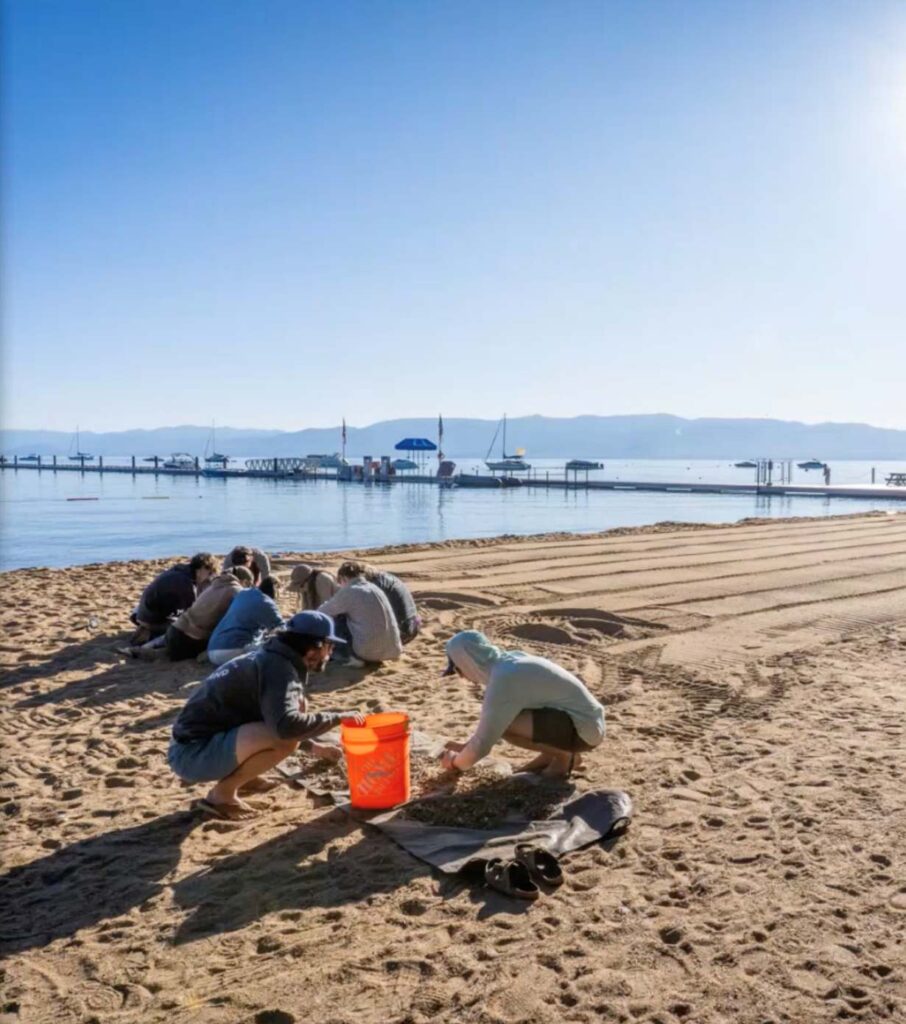
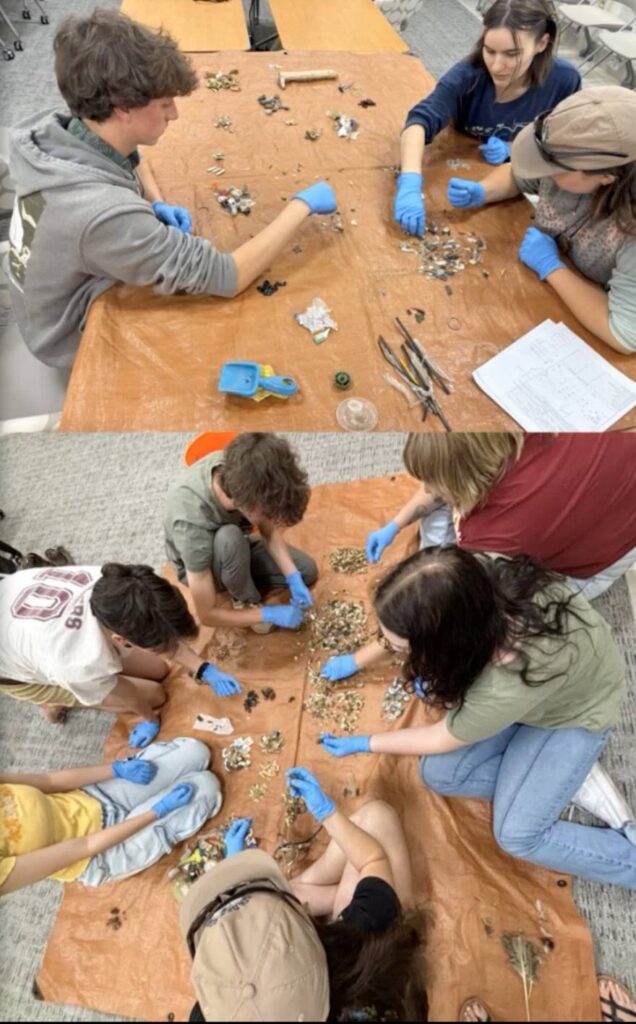
To examine possible litter sources, the interns assessed prevailing wind patterns on the lake, finding possible correlations for the higher amounts of litter at certain beaches. They also assessed the trash cans used at each beach to determine if the number and type of bin or their placement could be changing their usage.
The interns determined that future research considerations include increasing public education and signage about food waste, surveying beach users about their use of beach waste bins, and comparing litter collected before and after the 4th of July holiday.
Project: Health impacts of extreme heat and wildfire smoke
Student Researcher: James Cabalbag, Sara Wilson, Sigourney Kendall-Golder, Riley Sherman
Faculty Mentors: Yeongkwon Son, Associate Research Professor of Environmental Health, and Kristin VanderMolen, Assistant Research Professor of Atmospheric Science
With Reno now known as the fastest-warming city in the nation, extreme heat is both a present and growing threat to communities. When high temperatures overlap with days where wildfire smoke fills the air, managing both problems in a way that maintains comfortable temperatures and clean air can be a challenge. Interns James Cabalbag, Sara Wilson, Sigourney Kendall-Golder, and Riley Sherman participated in ongoing research led by DRI scientists Yeongkwon Son and Kristin VanderMolen to support healthy adaptations in Washoe County homes.
“The goal of this project is to understand the impacts on Washoe County households from exposure to these compound events of heat and wildfire smoke, as well as trying to support them,” intern James Cabalbag said.
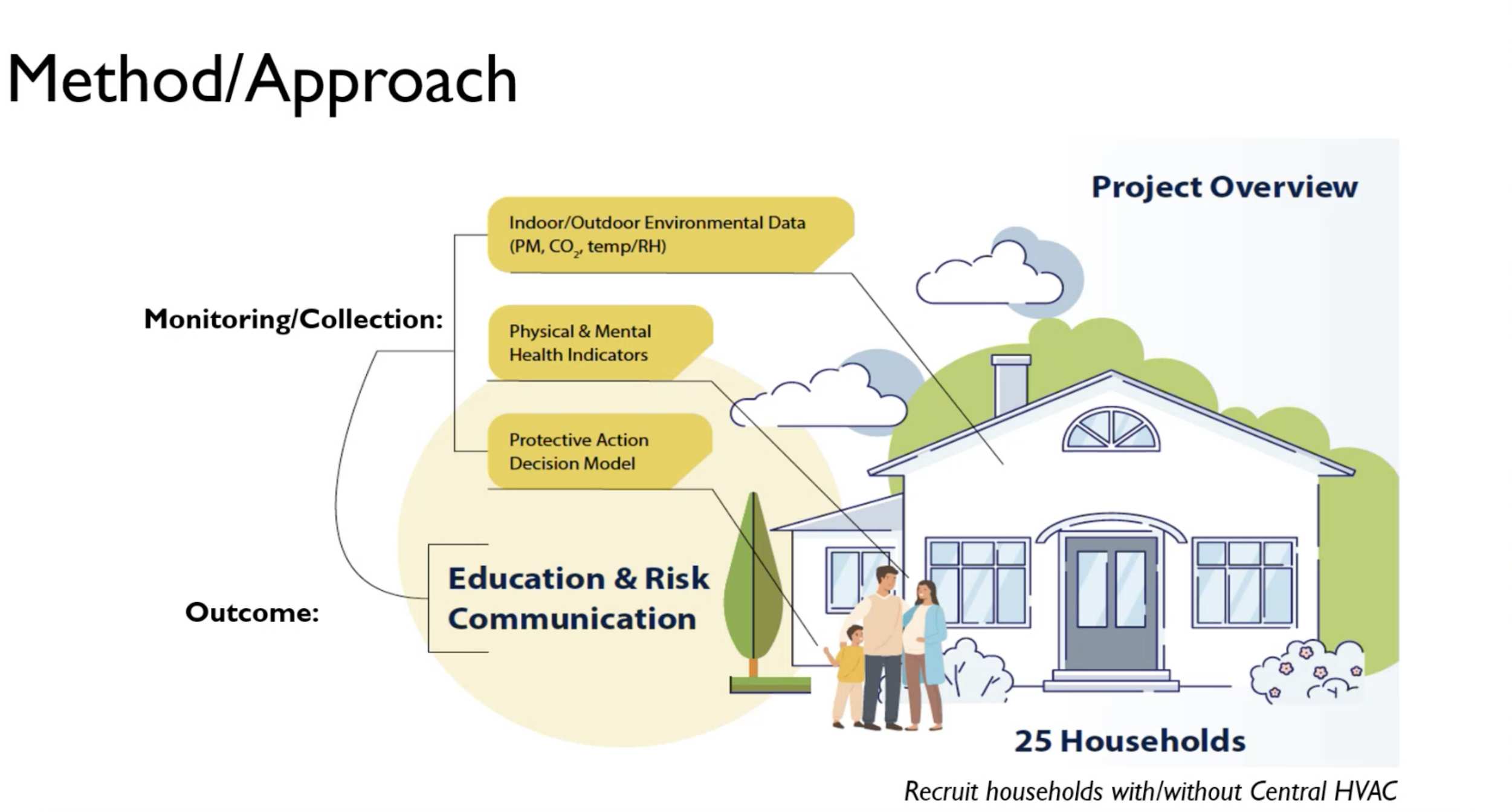
The researchers placed air quality monitors outdoors as well as inside of project participants’ homes, allowing insight into how well their current temperature control methods (central AC/window units/opening windows) protected their indoor air quality. The project recruited 25 households, some with central air conditioning and some without, and measured their physical and mental health using surveys and basic health metrics.
“When communicating with others as a researcher, it’s really essential to maintain an open mind and remain unbiased,” said intern Riley Sherman. “This was particularly important in our study because participants were sharing a lot of personal information with us, and by doing this they were more responsive and felt more comfortable.”
Project: Understanding Nevada’s Groundwater- Geospatial Data and Machine Learning
Student Researchers: Eleanor Muir, Jenae Payne, Brian Padilla, and Isabel de la Garza-Gibson
Faculty Mentors: Sayantan (Monty) Majumdar, Assistant Research Professor of Hydrologic Sciences and Remote Sensing, and Roger Putnam, Instructor at TMCC
The Great Basin is a region with serious water challenges that are only expected to grow more severe. Alongside growing cities and farms, data centers are proliferating, all of which require ever more water to thrive. At the same time, the warming atmosphere draws more moisture from soils, plants, and waterways, reducing the amount of water available on Earth even when precipitation is unchanged. Understanding how much water is stored in underwater reservoirs is key to helping managers develop plans for using water sustainably, now and into the future. Monty Majumdar is part of the DRI team working with the Nevada Division of Water Resources on the Nevada Water Initiative, an effort to build a more accurate understanding of the state’s groundwater resources.
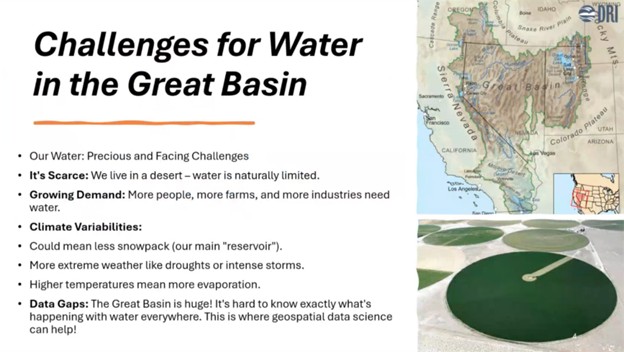
Under Majumdar’s guidance, the students were introduced to public datasets where they could obtain geospatial data, including DRI’s OpenET, and taught how to analyze it during a bootcamp for the coding platform, Python. TMCC’s Roger Putnam integrated geology into the lesson plans to demonstrate how water permeates into aquifers with a soil porosity lab. The students then conducted a final project where they selected specific water basins in Nevada and used the data to code maps in ArcGIS.
“We used Python to take the raw data and input it into a visual aid,” intern Eleanor Smith said. “It’s really amazing what ArcGIS and Python can do together.”
They trained three different machine learning models to determine their ability to predict changes in groundwater levels over time, using Nevada’s Pine and Antelope Valleys as focus areas.
“The interns received hands-on training for different computational tools that are required not only for hydrology but for any geoscience research,” Majumdar said.
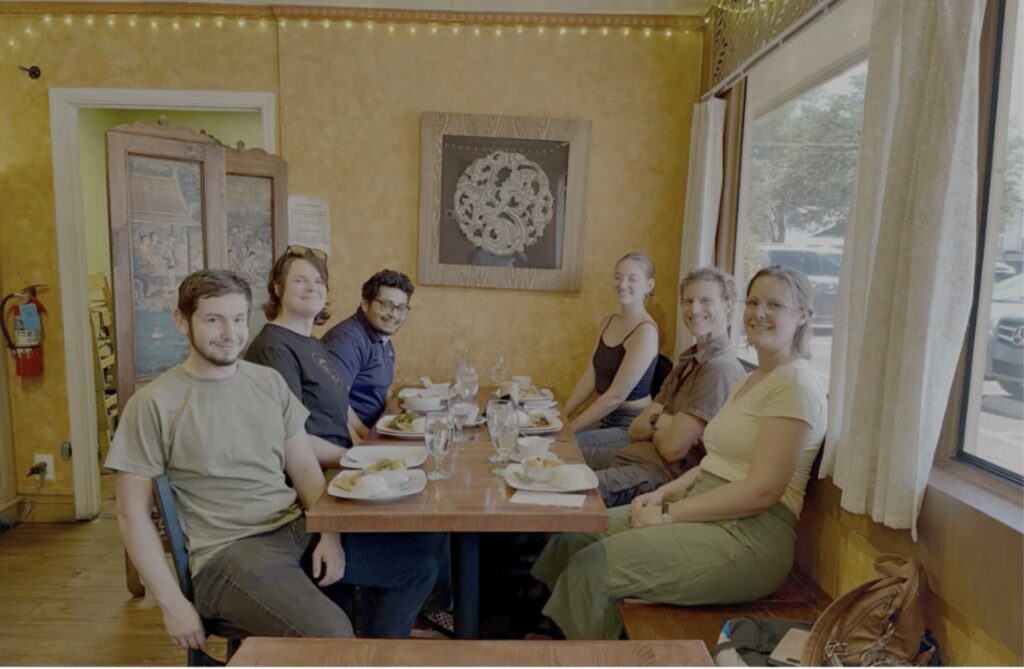
Project: Using Landforms to Infer Presence of Water Ice on Mars
Student Researchers: Robert Tolle, Kyle McKenna, Jennifer Hancock, and Egie May Escover
Faculty Mentor: Shannon Hibbard, Assistant Research Professor of Geomorphology
Out all of Earth’s neighbors, Mars has perhaps the most allure to humanity. The red planet is the focus of numerous space missions, with ambitious projects set to further our knowledge of its history. Central to the question of whether life has ever existed on the planet is determining the status of water and ice, and scientists still aren’t sure whether ice lurks just below the surface. This information could help planning efforts for future human exploration as well as in reconstructing Mars’ past climate. Under Shannon Hibbard’s guidance, the interns set out to investigate how landforms vary across the planet’s surface, as well as how this variation relates to ice distribution, stability, and accessibility for future landing sites.
The team focused on a location known as Arcadia Planitia, a region of Mars’ Northern Hemisphere and a proposed landing site for future missions. Hibbard has previously published research mapping glacial units in the region, which could potentially indicate areas with abundant ice. Martian landforms that may be linked to the presence of ice are known as polygons and brain terrain, the latter named for a resemblance to the wavey texture of a brain.

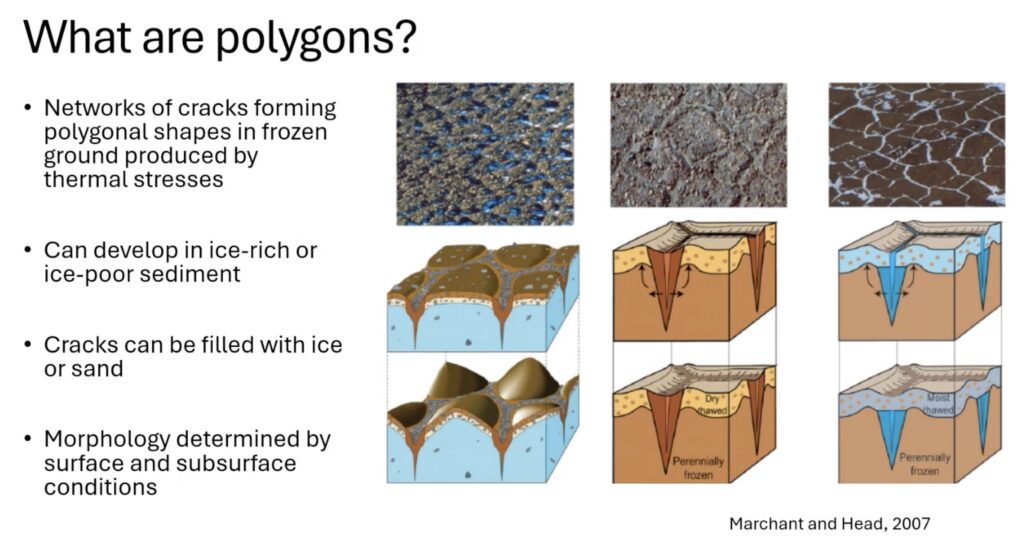
The interns used multiple datasets from Mars missions dating back to the 1990s, including elevation, slope, albedo, dust, rock abundance, thermal infrared, and radar information. They then generated statistics of each dataset for each map unit for all of Arcadia Planitia. By looking for statistically significant differences between map units, the research team hoped to identify differences that could point to the presence of ice.
Project: Ancient Landscapes- Lab Techniques and Interpretation of Soil Chemistry
Student Researcher: Minh Ngoc Dao
Faculty Mentors: Kathleen Rodrigues, Assistant Research Professor of Luminescence, and Saige Howard, Graduate Research Assistant
DRI’s Luminescence Lab uses advanced technology to answer questions about human and Earth history. With guidance from Kathleen Rodriguez and Saige Howard, intern Minh Dao learned techniques for handling and preparing soil samples from New Mexico, Pakistan, Arizona, and Texas for analysis. The process involves isolating specific elements and compounds, including Rubidium, Thorium, Uranium, and Potassium Oxide.
Dao’s project focused on analyzing soil collected from an archeological site near the Bois d’Arc Reservoir in Texas. His research questions centered on determining whether the soil chemistry changed according to the depth. He also examined organic matter in the soil, such as fish, fruits and meat, and found that it decreased with depth. He found that although the soils aged the deeper they were from the surface, the depth-age pattern wasn’t consistent over time. This could be attributed to nearby river flows carrying and depositing sediments at different rates over time.
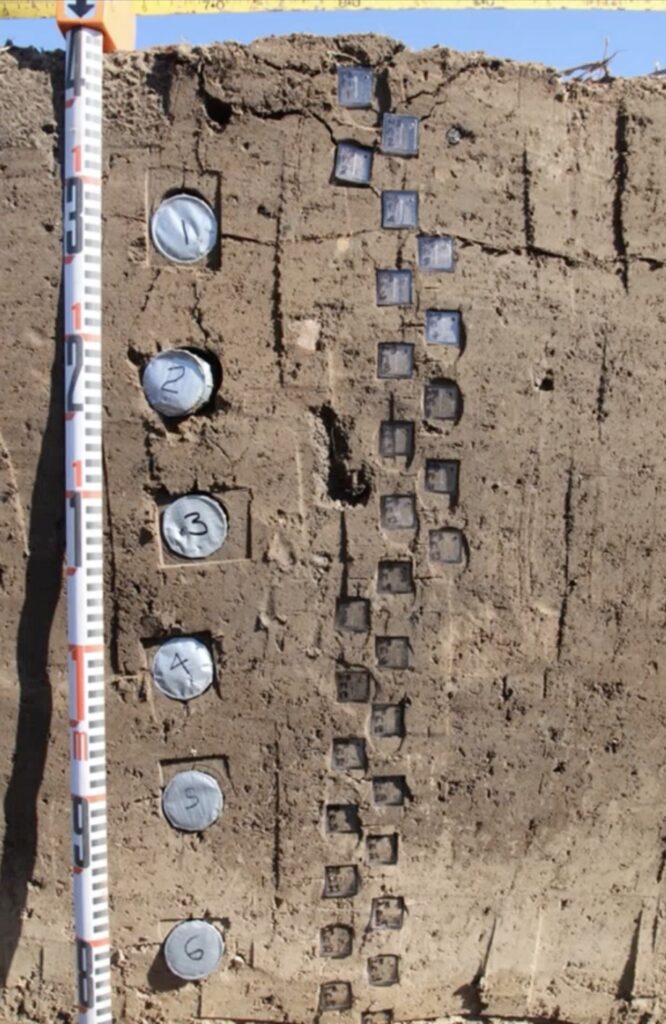
“I learned about geology and how landscape change over time can help us create a story to understand the formation of Earth’s surface,” Dao said.
—————————–
For more information about DRI’s internship programs, visit: https://www-dev.dri.edu/immersion/
